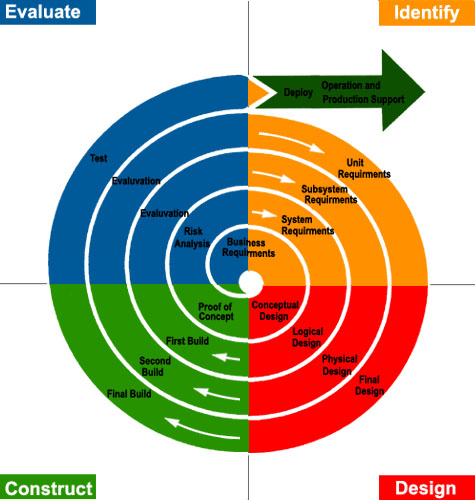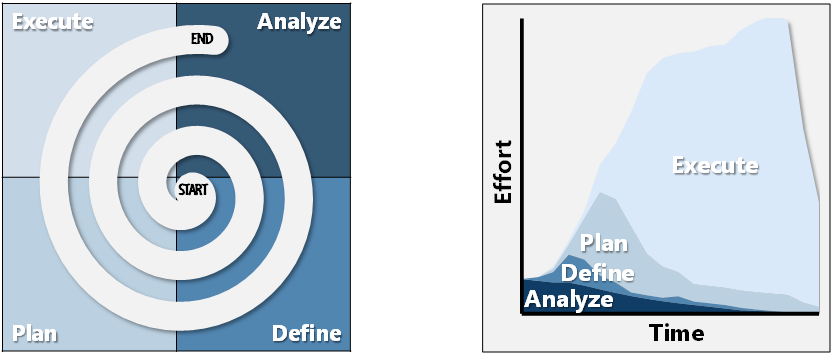A call for agile strategy development
Globalization, fiercer competition and shorter innovation cycles challenge classic intermittent strategy development approaches. Agile methods turn strategy development into a continuous activity ensures alignment with changed situations, improves execution and reduces wasting resources in pursuit of obsolete objectives.
Every year the executive offices are suddenly empty. It’s “strategic planning off-site” time: Review last year’s plan, do a SWOT, define the objectives for next year, write a long strategic plan and hand it to those who weren’t a part of its creation for implementation. They followed the book. Most strategy development approaches are simple and logic. Here is one example (OGSM):
- Assess the landscape
- Decide what to achieve
- Define milestones
- Choose how
- Measure it
- Communicate it
- Execute it
Great! Your strategy is defined and rolled-out. And then? Not much happens! 60% of employees rate their organization as weak at execution. Many things can go wrong during execution which include:
Efforts increase. Thinking about opening an office in China is so much easier than doing it. What it really takes to finish is impossible to know for sure. Rarely, sufficient resources are provided to ensure follow-through. Instead, the burden is put on the shoulders of the existing staff which is increasingly over-optimized by end-less cost cutting and “optimization” exercises and has only few if no capacity left for non-operational tasks. Short-term operational problems take precedence and strategy execution suffers.
New facts emerge. Your competitor is already in China, sales are not picking-up as planned due to an economic downturn, the efficiency of the new chip design is not as high as expected. With every step you move closer to your objectives you will have a new perspective and see things differently. As you dive into details, new dependencies and problems will emerge . Complexity rises, milestones are missed, efforts increase evenfurther, the execution stalls.
So what can you do? Put more pressure on your people to work harder? Squeeze more from your resources? Stampede ahead in blind ignorance of the new facts hoping that they will go away?
Surely, not every problem or push-back warrants a change in plan. Focus, commitment and urgency are important to ensure the success of any strategy. Bold goals will face resistance. But wouldn’t a more sensible approach to strategy execution also allow you to adjust the plan as well?
The above examples of sequential tasks do not allow for that. Assessment is only done at the beginning. Instead, it should be a continuous activity that looks out for internal and external changed situations, new facts and monitors the effectiveness of the execution.
Instead of a following a sequential/phased line of activities, strategy execution needs to be a more circular or parallel set of activities that constantly instills a sense for realism into execution.
In analogy to software development this could be called an agile strategy.
Agile Software Development
Until the end of the 90ies software development also followed a sequential phase model:
- Identify the requirements
- Design the solution
- Construct the solution
- Deploy the solution
This is called the water-fall model as it does not provide for going back to the previous phase. It works well for simpler and smaller solutions. But as their complexity, scope and implementation duration increased in the 90ies, problems emerged that led to spectacular failures and “death-march” projects that burned resources, people and entire companies.
This is where agile methods came to the rescue. Agile methods like the Rational Unified Process (RUP) parallelize the previously sequential software development activities or allow spiral development where several short e.g. 4 week long iterations/phases of Identify, Design and Construct create a subset of the overall functionality and validate it with the end users before proceeding to the next iteration.
This is how a spiral software development model looks like:

Source: American Informatics
This not only prevented large failures but also solved the issue with users “not knowing what they want until you show them what they can get”. Evolutionary and iterative development carries slightly higher cost than a perfectly executed water-fall implementation as small parts may require adjustment and re-writing later. But it avoids the run-away cost or total failures previously encountered with the water-fall model and therefore became the accepted standard for complex software development projects.
Agile Strategic Planning
Similar to software development, the complexity of strategy development is increasing. Globalisation, faster innovation cycles, stronger competition are only some of the factors that make it harder and harder to devise stable, long-lived and eventually successful strategies. Agile strategic planning addresses this by keeping the strategy fluid.
In applying this to strategic planning, this is how an agile strategy development process could look like in a spiral and parallel version:

Source: Forward Intelligence Group
The spiral model defines short iterations of 6-12 weeks during which a part of the overall strategy is implemented. Every 6-12 weeks the status and overall business situation is (re)analyzed and the strategy adjusted accordingly.
The parallel model goes one step further and changes sequential phases into parallel activities which are continuously executed in parallel.
Agile strategy development shares the following characteristics with agile software development:
- Continuous monitoring of the external environment during the Analyze activity.
- Regular review and – as required – updating of strategic objectives and plans during the Define and Plan activities.
- Frequent feedback from Execution on the effectiveness of the implementation.
In addition, agile strategy requires:
- A permanent strategy function. Instead of defining a new strategy every few years as part of a project, the strategy definition becomes an constant internal activity.
- Internal ownership. Strategy needs to be lived and owned by the organization. The strategy function will be the formal owner of its development but ownership needs to reside with the management team and beyond.
- Less external input. The old model of outsourcing strategy definition to external consultants will be less viable although external expertise continues to be an important input to ensure strategy quality.
Benefits
Shifting from phased to agile strategy development takes a change in mindset but it is not difficult to do and has many benefits:
- Smoother and more reliable execution due to higher degree of internal ownership.
- Lower resource usage due to the regular review and optimization of the activities and deliverables.
- Higher organizational agility due to the constant adjustment of the strategy to external developments.
“Leadership is about creating a domain in which human beings continually deepen their understanding of reality and become more capable of participating in the unfolding of the world.” – Peter Senge

